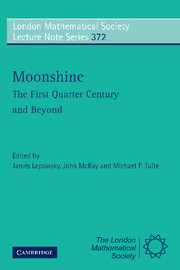 Moonshine - The First Quarter Century and Beyond
Moonshine - The First Quarter Century and Beyond Published online by Cambridge University Press: 06 July 2010
Abstract
In the 1980's, the work of Frenkel, Lepowsky and Meurman, along with that of Borcherds, culminated in the notion of vertex operator algebra, and an example whose full symmetry group is the largest sporadic simple group: the Monster. Thus it was shown that the vertex operators of mathematical physics play a role in finite group theory. In this article we describe an extension of this phenomenon by introducing the notion of enhanced vertex operator algebra, and constructing examples that realize other sporadic simple groups, including one that is not involved in the Monster.
Motivation
We begin not with the problem that motivates the article, but with motivation for the tools that will furnish the solution to this problem. The tools we have in mind are called vertex operator algebras (VOAs); here follows one way to motivate the notion.
In mathematics there are various kinds of finite dimensional algebras that have proven to be significant or interesting in some respect. For example,
(1) semisimple Lie algebras (with invariant bilinear form)
(2) simple Jordan algebras (of type A, B, or C)
(3) the Chevalley algebra (see [Che54])
(4) the Griess algebra (see [Gri82])
The items of this list are very different from each other in terms of their properties and structure theory. Perhaps the only thing they have in common (as algebras) is finite dimensionality.
Nonetheless, it turns out that there is such a process called affinization which associates a certain infinite dimensional algebra structure (let's say affine algebra), to each finite dimensional example in this list.
To save this book to your Kindle, first ensure [email protected] is added to your Approved Personal Document E-mail List under your Personal Document Settings on the Manage Your Content and Devices page of your Amazon account. Then enter the ‘name’ part of your Kindle email address below. Find out more about saving to your Kindle.
Note you can select to save to either the @free.kindle.com or @kindle.com variations. ‘@free.kindle.com’ emails are free but can only be saved to your device when it is connected to wi-fi. ‘@kindle.com’ emails can be delivered even when you are not connected to wi-fi, but note that service fees apply.
Find out more about the Kindle Personal Document Service.
To save content items to your account, please confirm that you agree to abide by our usage policies. If this is the first time you use this feature, you will be asked to authorise Cambridge Core to connect with your account. Find out more about saving content to Dropbox.
To save content items to your account, please confirm that you agree to abide by our usage policies. If this is the first time you use this feature, you will be asked to authorise Cambridge Core to connect with your account. Find out more about saving content to Google Drive.